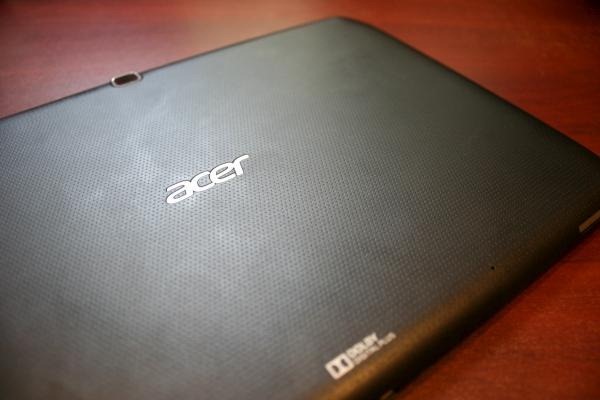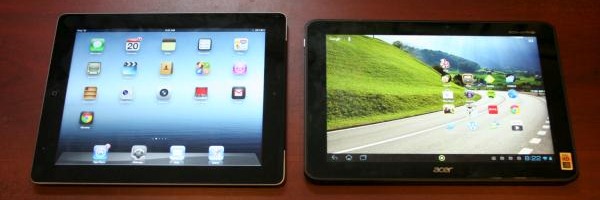In a somewhat crowded field of 10-inch Android tablets, Acer’s $450 Iconia Tab A700 sets itself apart by offering a whopping 1920×1200-resolution screen. Compared to most 10-inch tablet screens, the screen on this tablet makes text look better, images look better, and videos look better. Just about everything looks better on the A700.
It’s by far the tablet’s best asset, an asset which stacks up against two other tablets sharing a similar form factor right now: Apple’s third-generation 9.7-inch iPad, with its 2048×1536-resolution Retina display, and the Asus Transformer Pad Infinity, another new 10-inch Android tablet which, like Acer’s tablet, features a 1920×1200-resolution screen.
(MORE: 12 Unique Computers, Tablets and Gadgets That Are Just Around the Bend)
While both the Apple and Asus tablets start at $500, Acer’s managed to price the A700 at $450. Whether that $50 savings is enough to push Acer’s tablet ahead of the other two is where things start to get a bit tricky — but we’ll come back to that in a bit.
Aside from its undeniably eye-pleasing screen, build quality is another area where the A700 scores decently. But that’s not because it’s svelte and lightweight; it’s actually a bit on the porky side as tablets go, measuring 0.43 inches thick and weighing 1.47 pounds. However, the tablet has a reassuring solidness to it, and the design of the grippy, rubbery-feeling backside makes toting the A700 from room to room a far less stress-inducing experience than it is with slick-backed tablets like the iPad.

To push all the screen’s pixels around, Acer went with a 1.3GHz quad-core Tegra 3 processor paired with a 12-core Nvidia GeForce graphics chip and one gigabyte of DDR2 memory. This setup generally does a fine job when it comes to navigating around the tablet’s operating system — Android 4.0 — though I still experienced occasional sluggishness from time to time, especially when navigating web pages with a lot of images.
As for battery life, you can expect to get a full work day out of the A700 under moderate use. Acer claims “nearly” eight hours of continuous web surfing or up to 10.5 hours of offline video playback. Anecdotally, I found myself recharging the tablet every 3-4 days when using it for a few hours each day. The Tegra 3 chip does an impressive job of maintaining the battery’s charge level when the tablet’s not in use, too. That being said, the backside of the A700 tends to get hot rather quickly even when doing relatively rudimentary tasks.
(MORE: 6 Tablets to Consider for Windows 8′s October Launch)
The biggest issue with the A700 isn’t that it’s outright bad at anything it’s trying to accomplish; it’s that it’s just pretty good at everything. And pretty good in the ultra-competitive tablet market is still a tough sell. The 1920×1200 screen is downright gorgeous, sure. It’ll ruin lower-resolution 10-inch tablet screens for you. But $50 gets you a few more bells and whistles.
For instance, laying out another $50 for Asus’ new tablet gets you a 1.6GHz quad-core Tegra 3 processor and one gigabyte of more efficient DDR3 memory. The Asus tablet’s screen also uses newer IPS (in-plane switching) technology that makes it easier to see outdoors and features a higher maximum brightness level than Acer’s tablet. And you’ll get an 8-megapixel rear-facing camera versus Acer’s 5-megapixel rear-facing camera.
Therein lies the rub. Who’s the ideal owner for this tablet?
If you want a 10-inch Android tablet with an excellent screen, you owe it to yourself to at least take a look at the Asus tablet while you’re making your decision. If you just want a 10-inch tablet, it’s hard not to recommend the new iPad (or even the $400 iPad 2) given the abundance of great apps that are available — though it’s important to point out that you’ll only get 16 gigabytes of storage from a $500 iPad versus 32 gigabytes of storage from Acer. (Asus’ tablet sports 32 gigabytes as well. Both Android tablets have HDMI ports, USB ports and the ability to add more storage, too.)

If you just want an Android tablet, Google’s new $200 Nexus 7 tablet is really hard to argue with. If you want a smaller iPad, well, there may be one on the way in a few months. What we’re left with, pretty much, is someone who wants a 10-inch Android tablet with a great screen, doesn’t want to spend $500 on it, but is willing to spend $450 on it.
If you’re interested in this particular tablet, my advice would be to wait it out for a month or two if you can. Historically, Acer hasn’t been overly shy about cutting prices to move some of its products, and this tablet is a much easier sell at $400 ($350 would make it seem like a downright steal). Don’t get me wrong: This is the best tablet Acer’s ever made. There are just too many other alternatives out there right now to make this one a sure thing.
MORE: Nexus 7 Niceties: 15 Best Apps for Google’s New 7-Inch Tablet

